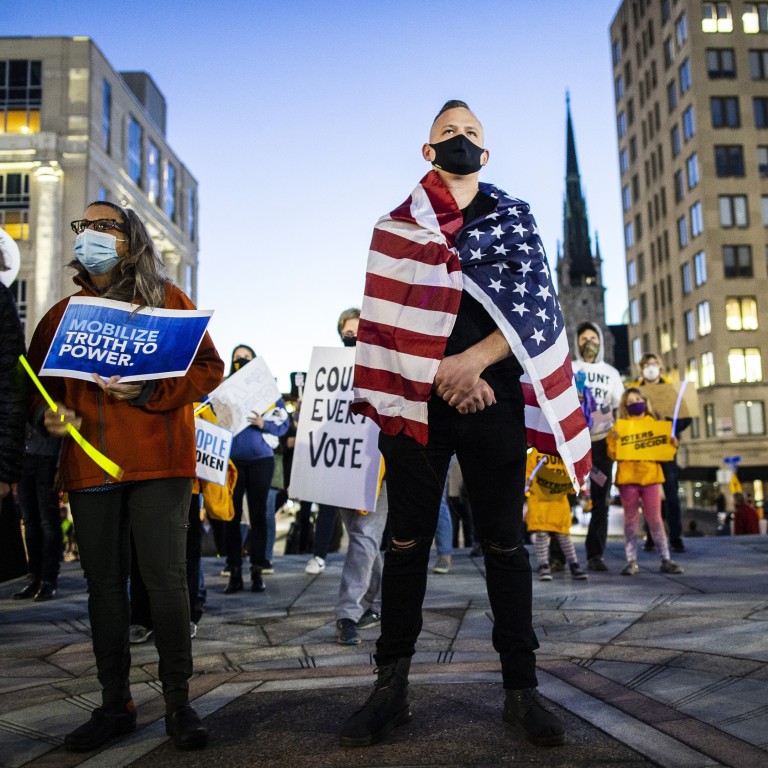
US election 2020: three ways Joe Biden undermined Donald Trump in the Midwest
- If margins matter in tight elections, Biden’s whittling away at Trump’s 2016 leads in Michigan, Wisconsin and Pennsylvania has made all the difference
- Biden did not need Obama-era turnout by Black voters, he just needed to improve on Clinton’s performance in the last election
This story is published in a content partnership with POLITICO. It was originally reported by Tim Alberta on politico.com on November 4, 2020.
Michigan, Wisconsin and Pennsylvania giveth, and Michigan, Wisconsin and Pennsylvania taketh away.
The story isn’t that Trump’s luck appears to have run out. The story is that challenger Biden is poised to beat him with the same hand.
Wisconsin has counted all its ballots and Biden is ahead by roughly 20,500 votes – almost the same as Hillary Clinton’s loss in Wisconsin by 22,748 votes.
In Michigan, the final ballots from Democratic precincts in Detroit are still being tallied. Those will add some cushion to Biden’s current lead of 120,000 votes and he seems destined to win the state by a couple of percentage points, four years after Trump carried Michigan by just 10,704 votes.
Pennsylvania will take the longest of the three to complete its count. As of Wednesday night (US time), Trump clung to a shrinking lead of some 190,000 ballots. But with nearly a million ballots outstanding – most in blue precincts in Philadelphia and elsewhere – Trump is expected to lose that lead. The size of any Biden win is unclear, but it may not be by much more than Trump’s victorious margin four years ago of 44,292 votes.
Here are three reasons Democrats may sweep the three critical Midwestern battleground states and win back the White House.
1) Biden kept Trump from running up the score with working-class whites
Trump’s team envisioned adding another 5 points or so to his 2016 showing, flipping the county and eating further into the Democratic Party’s dwindling base of white working-class supporters.
But the opposite happened. Biden won Lackawanna County by 8 points. Instead of gaining 5 points Trump lost 5 points.
It’s easy to chalk up these results to Biden’s home-field advantage. But that would fail to explain what happened in Macomb County.
US election results show Trump improved margins in some Covid-19 hotspots
Expecting losses among college-educated voters in upscale areas, Trump’s team was determined to add gains in middle-class, blue-collar communities like in Macomb County.
Home to the fabled “Reagan Democrats” of the 1980s, Macomb has drifted right over the past three presidential elections. Democrats carried it by nearly 9 points in 2008 and 4 points in 2012, only to watch Trump dominate with a 12-point win in 2016.
There was real reason for optimism among Republicans that Trump could add another 3 or 4 points to that spread, padding his margins in friendly territory.
Again the opposite happened.
Trump won Macomb County by 8 points, losing 4 points off his 2016 total. This was arguably the most surprising result in Michigan. In a county tailor-made to his politics, it was also part of a broader letdown in his efforts to juice white working-class votes across the board.
2) Biden peeled away Trump’s support in conservative suburbs
In Wisconsin, the suburbs outside Milwaukee constitute the most conservative metropolitan area in the country. Each of the three counties that surround the city – Waukesha, Ozaukee and Washington, the “WOW” counties – have voted Republican in every presidential election since 1968, and by double-digit margins. These counties are each wealthy, exceptionally well-educated and north of 90 per cent white.
In 2016, the president carried the WOW counties by yawning margins. Washington was decided by 40 points, Waukesha by 27 and Ozaukee by 19 points.
Four years later, Biden closed the gap in all three. Trump won Washington by 38 points, Waukesha by 21 points and Ozaukee by 12 points.
In a vacuum, those totals might not seem noteworthy. But together as a picture of suburban Milwaukee and a wider snapshot of wealthy white suburbs across the Midwest, they are the difference between a President Trump and a President Biden.
According to the final (though yet uncertified) election results, Biden carried Wisconsin by just over 20,000 votes. With a margin that narrow, any number of things are key. But it’s tough to argue that Trump’s slippage in the Milwaukee suburbs wasn’t the essential ingredient of his loss.
The same reality was apparent in Michigan.

Livingston County, which contains the exurbs of Detroit and Ann Arbor, has long been the most reliable source of Republican votes in the state. Four years ago, Trump carried the county by 30 points, and his team hoped to match that in 2020.
Trump carried Livingston County by 22.5 points against Biden. It’s a healthy margin, but it’s also a dramatic fall-off from his showing against Clinton four years ago.
Margins matter in tight races. The story of 2020, in the Midwest and elsewhere, was Biden whittling down the president’s margins in the conservative suburbs where Trump’s team thought he might be safe.
3) Biden got Black voters to turn out in big numbers
Some things in politics are pretty straightforward. This is one: Clinton lost to Trump because she did not mobilise Black voters.
This was especially conspicuous in the three determinative Midwestern states, because of the sizeable Black populations in the biggest cities of Wisconsin, Michigan and Pennsylvania.
Milwaukee and surrounding Milwaukee County are home to the biggest share of Black voters in Wisconsin. In 2012, Obama won roughly 328,000 votes in Milwaukee County. Four years later, Clinton won fewer than 289,000 votes there.
The challenge for Biden wasn’t to get back to that Obama 2012 number; rather, it was to split the difference. With all the votes counted, more than 317,000 people in Milwaukee County voted for Biden and he needed every single one.
It was a similar story in Detroit, a city that’s more than 80 per cent Black, and its surrounding Wayne County.
In 2012, Obama won nearly 596,000 votes in Wayne County. Four years later, Clinton got fewer than 520,000.
Why the Supreme Court probably won’t help Trump’s re-election fate
Once again, the question was whether Biden could push somewhere close to that Obama 2012 number. As of writing, roughly 15 per cent of Wayne County’s ballots are outstanding, but Biden has already won 568,000 votes there.
Finally, we have Philadelphia, a city with a plurality of Black voters, and surrounding Philadelphia County.
In 2012, Obama won some 557,000 votes in Philadelphia County, but Clinton beat that in 2016, winning 584,000 votes.
That said, a closer examination revealed that Clinton’s strong turnout came in whiter and wealthier precincts of the county, rather than its working-class and less affluent neighbourhoods. Biden’s team knew he would need both to best Trump.
While votes are still being counted, it appears Biden will blow past both the Obama 2012 and Clinton 2016 numbers: he has banked 458,000 votes, and with hundreds of thousands more from the country outstanding, he may get into the 600,000-vote range.
These numbers on Black voter turnout track with smaller Black-majority areas as well. In Flint, Michigan, for example, and surrounding Genesee County, Democrats went from winning nearly 129,000 votes in 2012 to some 103,000 votes in 2016. This year? Biden topped 120,000 votes.
To win the presidency, Biden never needed Obama-era levels of turnout and support from Black voters. He just needed significant improvement on the performance of Clinton in 2016.
He got exactly that – and with it, more than likely, a four-year term as president.

